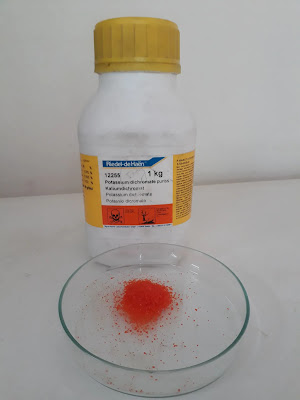Product Identification
- Uncovering the Safety – Potassium Dichromate SDS!
Physical & Chemical Properties
- Molecular formula: K2Cr2O7.
- Molecular weight: 294.185 g/mol.
- Melting point: 398°C (748°F).
- Density: 2.70 g/cm3.
- Vapor pressure: Not applicable.
- Solubility: Highly soluble in water, slightly soluble in ethanol.
Fire & Explosion Data
- Flash point: Not applicable.
- Autoignition temperature: Not applicable.
- Explosion limits: Not applicable.
- Extinguishing media: Not applicable.
- Special firefighting procedures: Not applicable.
Health Hazard Information
- Acute effects: Inhalation of dust may cause respiratory irritation and lung damage. Prolonged or repeated skin contact may cause severe irritation and burns. Ingestion may cause stomach upset, nausea, vomiting, & diarrhea. Eye contact may cause severe irritation & burns.
- Chronic effects: Prolonged or repeated exposure to potassium dichromate may cause cancer, lung damage, and damage to the liver & kidneys.
Handling & Storage
- Handle in a well-ventilated area.
- Wear appropriate personal protective equipment, including gloves and eye protection.
- Store in a cool, dry, well-ventilated area, away from heat & ignition sources.
- Keep the container closed when not in use.
- Use with adequate ventilation.
Spill or Leak Procedures
- Wear appropriate personal protective equipment.
- Ventilate the area.
- Dilute with water and flush to a sewer.
- Neutralize with a dilute solution of sodium bisulfite.
- Absorb with an inert material & place in a closed container for disposal.

Conclusion
When handled incorrectly, the inorganic chemical potassium dichromate can cause serious burns and irritation to the skin, eyes, nose, throat, & respiratory system. It also has the potential to cause cancer, and repeated or prolonged exposure can harm the liver & kidneys as well as cause lung and liver and kidney damage. It should be stored in a cool, dry, well-ventilated environment, away from heat and ignition sources, & handled with the proper personal protective equipment and ventilation. The right steps should be taken to neutralize & safely dispose of the item in the event of a spill or leak. It is crucial to remember that handling this chemical without the appropriate training is dangerous & should only be done under the supervision of a skilled specialist. One must follow Potassium Dichromate SDS!
